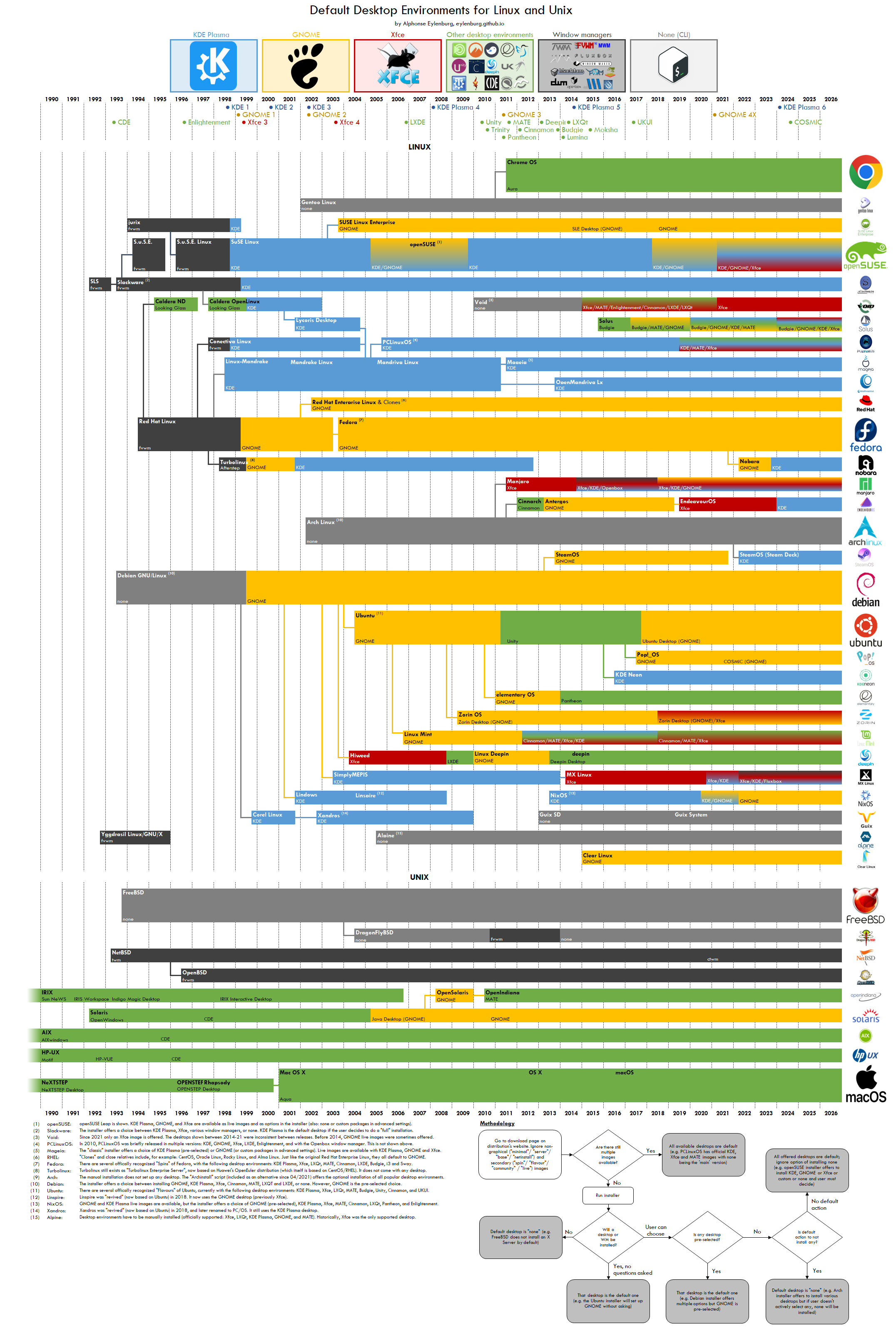Default Desktop Environments for Linux and Unix
Timeline since 1990 showing the most important distributions
Last updated: December 2025
The picture below shows the standard/default desktop environments used by the most popular Linux distributions and Unix systems, since 2020. Please note the small annotations that explain why a desktop environment was determined to be the default choice or not, as this is not straightforward for every distribution. Generally, I have regarded a desktop as being the "default" if either:
- It is the desktop environment that shows up after installation, with no questions asked during installation. That's the most obvious case. Examples: Ubuntu, elementary OS.
- It is the desktop environment that is pre-selected at installation, but the user can decide to install another desktop or none. Still, if you just click "Next" you'll end up with this desktop. Examples: Slackware, Debian.
- There are multiple desktop environments offered at installation, but none of them are selected by default. Examples: openSUSE.
- There are multiple images with different desktops available for download, so you have to choose your desktop environment before installing. Examples: Linux Mint, Budgie, Manjaro. These have to be presented equally on the website, hence Ubuntu Flavours and Fedora Spins don't count. A special case is Fedora where since Fedora 42 (April 2025) there are two "Editions" (Workstation with GNOME, and the KDE Plasma Edition) and then several "Spins" with other desktops.
The flowchart at the bottom right of the graphic explains the methodology.
You can find an older version of this (with a slightly different choice of distributions) HERE.

Click here to open the picture in a new tab
Main Findings
- Many traditional KDE distros died (e.g. Mandriva, MEPIS, Caldera OpenLinux, Xandros, Turbolinux, or Conectiva) or changed from being a pure KDE distribution to one offering a choice of multiple desktops (e.g. openSUSE [choice in installer, no pre-selection], PCLinuxOS [multiple images], Mageia [choice in installer, KDE pre-selected], NixOS [choice in installer, GNOME pre-selected]). On the other hand GNOME distributions stayed relatively loyal. In the early 2000s the most important distributions were SUSE (KDE), Mandrake (KDE), Debian (GNOME), and Red Hat (GNOME). Nowadays it would be openSUSE (KDE/GNOME), Ubuntu (GNOME), Debian (GNOME), and Fedora/RHEL (GNOME). From a 50/50 split to a 12.5%/87.5% split.
- "Newcomer" distros often don't prefer either GNOME or KDE. There's a trend towards "home-grown" desktops, such as Mint's Cinnamon, Solus's Budgie, elementary OS's Pantheon, Deepin's Deepin Desktop, or pop_OS!'s COSMIC, and another trend towards offering Xfce as a "neutral" desktop (default or "flagship" desktop for Manjaro, Endeavour OS, MX Linux, and Void).
- GNOME = Corporate Linux. Red Hat (RHEL, CentOS, Fedora) always used GNOME, because they are the main developers of GNOME in the first place. SUSE Linux Enterprise Desktop only offers GNOME, unlike the agnostic openSUSE and KDE-only earlier versions of SUSE Linux. Canonical/Ubuntu stopped the development of their own desktop environment Unity and went back to GNOME in 2017. Oracle Solaris only offers GNOME.
- KDE seems to be more popular with Continental European developers and GNOME with Anglo-American developers. The KDE-only or historically KDE-focused distributions - openSUSE, Mageia, OpenMandriva, NixOS, KaOS - are all from Continental Europe. The GNOME-only or historically GNOME-focused distributions - Fedora, RHEL, CentOS, Oracle Linux, Ubuntu, Clear Linux, pop_OS!, Zorin OS - are all from the Anglosphere.
